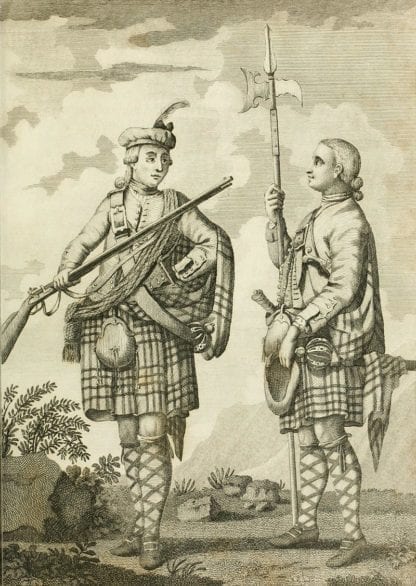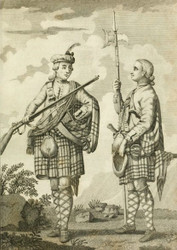Black Watch Mutiny
Posted by Charles MacGregor on Nov 11th 2018
Originally Published February 2011. Written for The Celtic Croft by Charles MacGregor of MacGregor Historic Games.
Black Watch Mutiny
After the 1715 Jacobite Rising the "Disarming Act" was passed by the Parliament of Great Britain, and went into effect November 1, 1716. It outlawed anyone in certain parts of Scotland from having "in his or their custody, use, or bear, broad sword or target, poignard, whinger, or durk, side pistol, gun, or other warlike weapon" unless authorized. To a large extent the act proved ineffectual and in 1725 an updated law was passed and more effectively enforced by Major-General George Wade. Wade succeeded in confiscating a significant number of useful weapons, though the Highlanders still managed to hide many of their arms.
To help preserve order in the Highlands without the expense of maintaining a standing army, the government first began recruiting men from local clans that had been loyal to the Whigs. This proved to be unsuccessful in deterring crime, especially cattle rustling, so independent companies (of what would be known as the Black Watch) were raised as a militia in 1725 by General George Wade to keep "watch" for crime.

Below is a description of the men who joined the ranks of the Black Watch in it's early days written by the earliest historian of the Highland Regiments, David Stewart of Garth:
"Many of the men who composed these companies were of a higher station in society that that from which soldiers in general are raised; cadets of gentlemen's families, sons of gentlemen farmers, and tacksmen, either immediately or distantly descended from gentlemen's families, - men who felt themselves responsible for their conduct to high-minded and honorable families, as well as to a country for which they cherished a devoted affection."
"Hence it became and object of ambition with all the young men of spirit to be admitted, even as privates, into a service which procured them the privilege of wearing arms. This accounts for the great number of men of respectable families who were to be found in the ranks of the Black Watch?"
Thus the early Black Watch troops seem to have been at least partially made up of young gentlemen wanting the honor to carry sword and musket, and perhaps fight in the heroic fashion of clan warfare like their forebears. In his book Highlander Stuart Reid wrote "Not unnaturally, the government was less than impressed by the set-up. It wanted an efficient constabulary, not a species of gentleman's club maintained at public expense."
In order to improve the discipline of Black Watch they were formally reorganized as the 43rd Regiment of Foot in 1739 (In 1751 they were formally renamed the 42nd (Highland) Regiment of Foot). Much to the dismay of their gentlemen soldiers, four addition companies were raised and recruited by the beat of the drum as were standard infantry regiments. The existing troops not only looked down upon the new "scrubs" as they called these common soldiers, but suddenly discovered that they would have to properly drill and exercise to become an efficient unit according the current models. Stewart of Garth, quoted above, wrote that "when this regiment was first embodied, it was no uncommon thing to see private soldiers riding to the exercising ground followed by servants carrying their firelocks and uniforms."
A break came in 1743 when the 43rd was selected to serve overseas in the escalating War of Austrian Succession. This came as shock to the gentlemen who signed on for the "privilege of swaggering around carrying the arms denied to lesser mortals by the 1724 Disarming Act" (-Reid: Highlander) They thought their tour of duty would consist of catching cattle thieves and dealing with the occasional recalcitrant Highland clan, and never dreamed they would actually be called on to serve in foreign lands like a regular army unit.
In addition, a rumor had reached them that they were to be embarked for the plantations of the West Indies. The fate of other regiments which had been sent to these colonies seemed to mark out this service as both perilous and degrading, as they would be exposed to the dangers and diseases of tropical lands, and with no enemy to fight that was worthy of their Scottish courage.
The Black Watch "Mutiny" was not so much what we think of as a mutiny against superiors, it was more an attempt at mass desertion. About 120 men led, by cousins Samuel and Malcolm MacPherson, attempted to run into the hills. The MacPherson cousins and one other man were shot and the remaining deserters were broken up and transferred to the regiments serving in the West Indies the Mediterranean, or Georgia.
In spite of this the rest of the regiment was believed to be reliable and was shipped off to Flanders. The regiment's first real service was the Battle of Fontenoy in 1745, where they served gallantly. Their commander allowed them "their own way of fighting" which was closer to the practices of Clan warfare and the Highland Charge than the drill of standard units. Whenever they received French fire Col. Sir Robert Munro ordered his men to "clap to the ground" rather than stand fast. According to Wikipedia: "For the first time in a European battle they introduced a system of infantry tactics (alternatively firing and taking cover) that was not superseded. Springing up and closing with the enemy, they drove them back several times, and finished with a successful rear-guard action against French cavalry."

